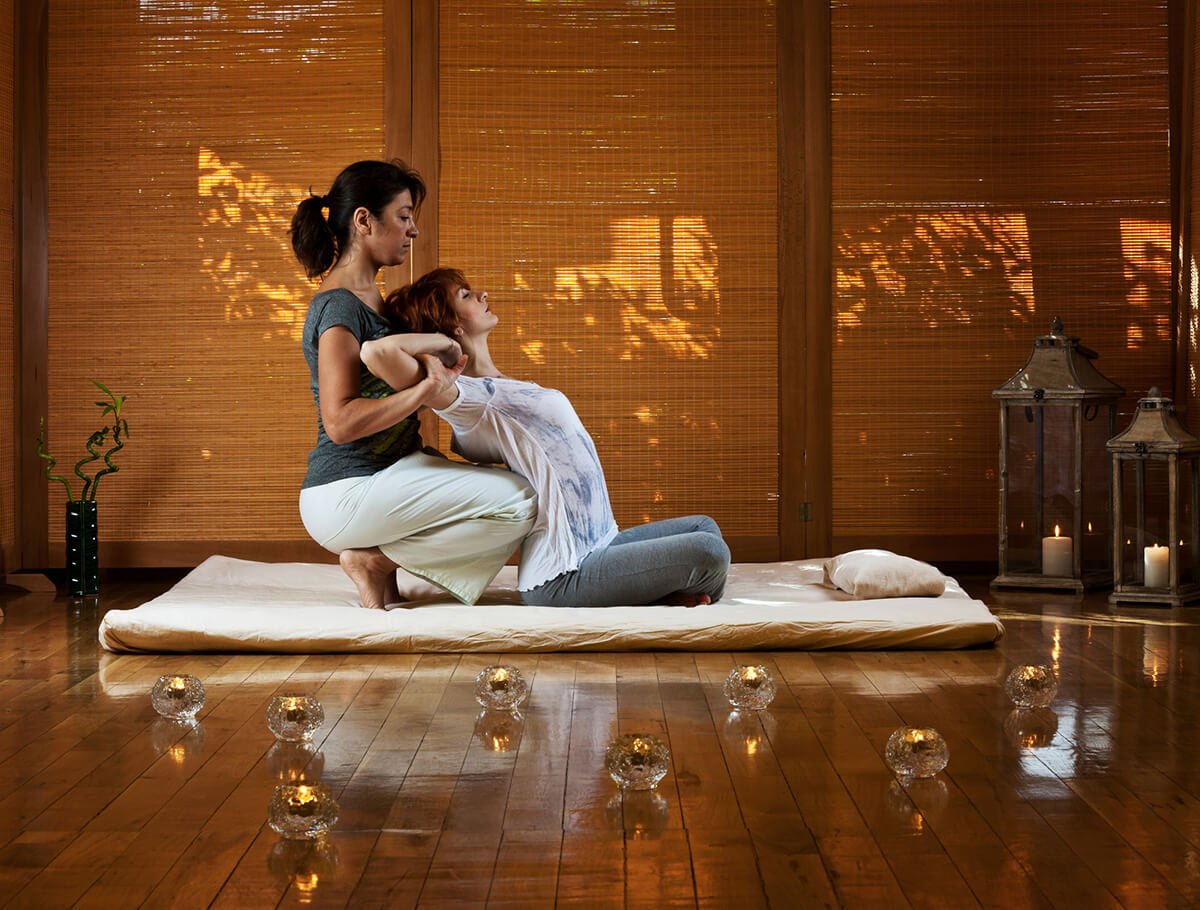Thai masaža
Thai ili tajlandska masaža predstavlja oblik istočnjačke tjelesne terapije, koja uključuje rad s energetskim poljima koja okružuju te prožimaju tijelo. Počeci thai masaže pojavljuju se pred oko 2500 godina. Tajlandska masaža istovremeno opušta i daje energiju. Maserke koriste noge, koljena, ruke i stopala kako bi “manipulirali” tijelom i doveli ga do sklada. Prednosti tajlandske masaže su brojne: otklanja psihički i fizički stres, opušta tijelo, ublažava tegobe s mišićima uzrokovane povećanim fizičkim naporima. Ova masaža pozitivno utječe i na kronične bolove, balansira rad cijeloga tijela, te pomaže u borbi protiv celulita.
Drevna znanja tradicionalne tajlandske masaže sakupljana su već od prvog liječnika Buddhe, te njegovih sljedbenika i prijatelja, a ista su se kroz dugi razvoj dopunjavala znanjem Ayurvede, Joge, Akupresure, Kiropraktike, Shiatshu masaže, prastarih civilizacija Indije, Kine i Japana. Pozitivne učinke opuštanja mišića, tetiva, razgibavanje zglobova, gipkost tijela, aktiviranje živčanog i probavnog sustava, dodatno upotpunjuju masaže sa eteričnim uljima tajlandskog i hrvatskog bilja, voća i cvijeća.

Povijest Thai masaže
Kao rezultat brojnih povijesnih događaja i destruktivne klime, do danas je preživjelo svega nekoliko povijesnih izvora. Štoviše, u mnogim regijama zemlje znanje se prenosilo usmenom predajom, a metode pojedinačnih vježbi ostale su obiteljska tajna čuvana generacijama. Trenutno su jedini izvor informacija o "tehničkim" temeljima kamene ploče s početka 19. stoljeća, koje prikazuju energetski sustav i akupresurne točke, te jedina preživjela skulptura iz istog razdoblja, koja prikazuje jedan od predmeta za masažu.
Istraživanja posljednjih godina omogućila su utvrđivanje najmanje pet različitih utjecaja na trenutni oblik tajlandske masaže:
Budizam - budistički medicinski tekstovi datirani nekoliko stoljeća prije Krista sadrže brojne podatke o anatomiji, vrstama bolesti i njihovom liječenju. Oni također ukazuju na značajnu ulogu prvog, osobnog Budinog liječnika i tvorca tajlandske masaže, Jivak Komarabhacca. Današnji spa terapeuti tajlandske masaže koriste elemente budističke tradicije kao što su etika, samilost i tehnike disanja.
Ayurveda - sustav indijske prirodne medicine. Studenti prirodne medicine još uvijek koriste udžbenike napisane u sedmom stoljeću prije Krista.
Joga - disciplina samopoboljšanja, meditacije i asketizma uspostavljena je u Indiji. Sličan sustav individualnih stavova i vježbi istezanja razvijen je i na Tajlandu. Mogu se uočiti sličnosti položaja tijela, nekih imena ili energetskih kanala.
Kultura Kine i drugih susjednih zemalja - kao rezultat stalnog kontakta i kulturne razmjene, tajlandski maseri razvili su vlastite tehnike refleksoterapije ili trbušne masaže.
Regionalne prakse tajlandskih liječnika imale su najveći utjecaj na ukupni oblik tajlandske medicine. Tehnike postavljanja kostiju (izvorni kiropraktik), hodanje po leđima (yam kaeng) ili udaranje specifičnih točaka po tijelu drvenim čekićem (tok sen).
Thai massage
Thai or Thai massage is a form of Eastern body therapy, which involves working with the energy fields that surround and permeate the body. The beginnings of Thai massage appear about 2500 years ago. Thai massage relaxes and energizes at the same time. Masseuses use legs, knees, arms and feet to "manipulate" the body and bring it into harmony. The benefits of Thai massage are numerous: it removes mental and physical stress, relaxes the body, relieves muscle problems caused by increased physical exertion. This massage also has a positive effect on chronic pain, balances the work of the whole body, and helps fight cellulite.
The ancient knowledge of traditional Thai massage has been gathered since the first Buddha doctor, and his followers and friends, and its long development has been supplemented by knowledge of Ayurveda, Yoga, Acupressure, Chiropractic, Shiatshu massage, ancient civilizations of India, China and Japan. The positive effects of relaxing muscles, tendons, stretching joints, body flexibility, activating the nervous and digestive systems, are further complemented by massages with essential oils of Thai and Croatian herbs, fruits and flowers.

History of Thai massage
As a result of numerous historical events and a destructive climate, only a few historical sources have survived to this day. Moreover, in many regions of the country, knowledge was passed on orally, and the methods of individual exercises remained a family secret kept for generations. Currently, the only source of information on the "technical" foundations of the early 19th century stone slab depicting the energy system and acupressure points, and the only surviving sculpture from the same period, depicting one of the massage objects.
Research in recent years has made it possible to identify at least five different influences on the current form of Thai massage:
Buddhism - Buddhist medical texts dating back several centuries before Christ contain numerous data on anatomy, types of diseases and their treatment. They also point to the significant role of the first, personal Buddha physician and creator of Thai massage, Jivak Komarabhacca. Today’s Thai massage therapists use elements of the Buddhist tradition such as ethics, compassion and breathing techniques.
Ayurveda - the system of Indian natural medicine. Natural medicine students still use textbooks written in the seventh century BC.
Joga - the discipline of self-improvement, meditation and asceticism was established in India. A similar system of individual postures and stretching exercises has been developed in Thailand. Similarities of body position, some names, or energy channels can be observed.
Culture of China and other neighboring countries - as a result of constant contact and cultural exchange, Thai masseurs have developed their own techniques of reflexology or abdominal massage.
The regional practices of Thai physicians have had the greatest impact on the overall form of Thai medicine. Bone placement techniques (original chiropractor), walking on the back (yam kaeng) or hitting specific points on the body with a wooden hammer (tok sen).

